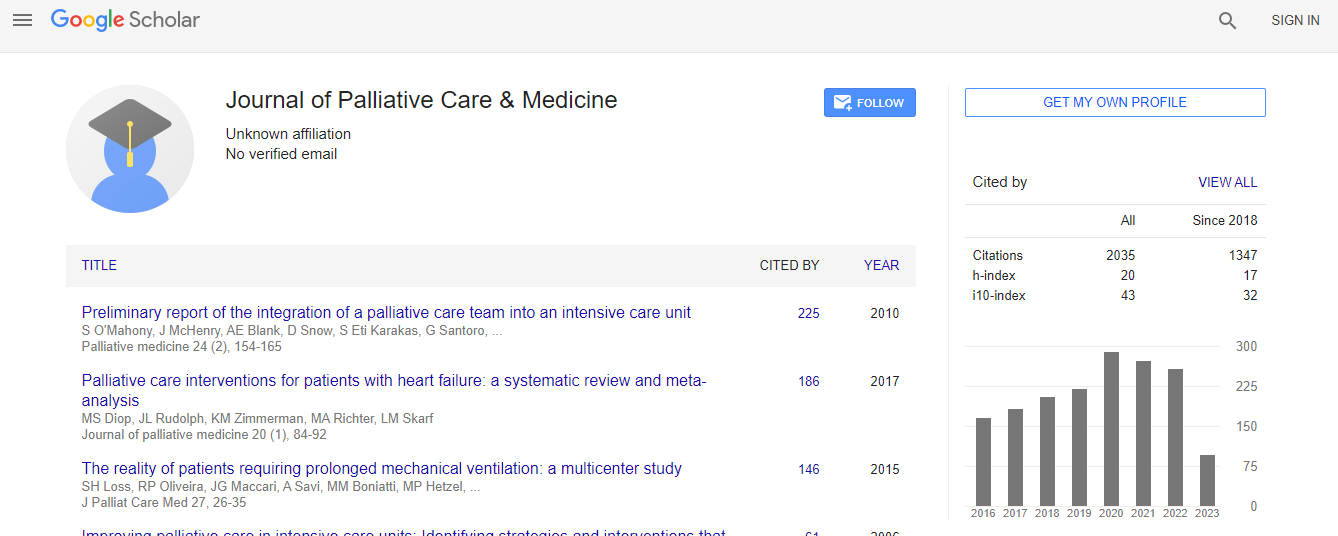Our Group organises 3000+ Global Conferenceseries Events every year across USA, Europe & Asia with support from 1000 more scientific Societies and Publishes 700+ Open Access Journals which contains over 50000 eminent personalities, reputed scientists as editorial board members.
Open Access Journals gaining more Readers and Citations
700 Journals and 15,000,000 Readers Each Journal is getting 25,000+ Readers
Recommended Conferences
42nd Global Conference on Nursing Care & Patient Safety
Toronto, CanadaGoogle Scholar citation report
Citations : 2035
Journal of Palliative Care & Medicine received 2035 citations as per Google Scholar report
Journal of Palliative Care & Medicine peer review process verified at publons
Indexed In
- Index Copernicus
- Google Scholar
- Open J Gate
- Genamics JournalSeek
- China National Knowledge Infrastructure (CNKI)
- Electronic Journals Library
- RefSeek
- Hamdard University
- EBSCO A-Z
- OCLC- WorldCat
- Virtual Library of Biology (vifabio)
- Publons
- Geneva Foundation for Medical Education and Research
- Euro Pub
- ICMJE
Useful Links
Recommended Journals
Related Subjects
Share This Page
An analysis of referral pattern of cancer clients to palliative care clinic: A retrospective report
5th World Congress on Hospice and Palliative Care
Divya T, Kalpana Balakrishnan, Azhar Hussain and Surendren Veeraiah
Adyar Cancer Institute, India
Posters & Accepted Abstracts: J Palliat Care Med
Abstract
Background: Palliative care is an integral component in cancer care. Palliative care is holistic care. Correctable problems should be corrected at the right time rather than waiting for the terminal stage of the disease. Objective: To evaluate the referral pattern followed in the tertiary cancer care center. Methods: A retrospective method of study was adopted to quantify the time gap between the first patient admission in cancer care and palliative care referral in-order to improve the quality of life of patients by the way of improving the referral system. Result: Out of 396 patients analyzed 209 (52.8%) were male and 187 (47.2%) were females. The mean age was 52.94 years (SD±14.007). Majority 59.3% (N=235) of patients fall under late adult category. Most of them were diagnosed with head and neck cancer 102 (25.8%), and reproductive system cancer 88 (22.2%). At follow up 204 (51.5%) were alive and 192 (48.5%) were dead. Among this patients died within six months were 180 (45.5%) from the time of registration at pain and palliative care clinic. Many of the patients (51.5%) were referred to pain and palliative care clinic within one year from the time of their registration at hospital. Conclusion: Palliative care improves the quality of life of people with life-threatening or debilitating illness by providing relief from pain and other physical symptoms and care for psychosocial needs. To ensure the most effective care for patients, palliative care begins at the point of diagnosis, continues throughout treatment and bereavement support is offered to the family after the patient’s death.Biography
E-mail: divyatdsj@yahoo.co.in

 Spanish
Spanish  Chinese
Chinese  Russian
Russian  German
German  French
French  Japanese
Japanese  Portuguese
Portuguese  Hindi
Hindi 
